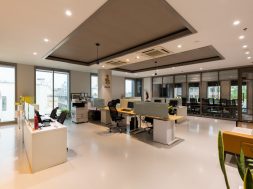Piled Raft Foundation Technology & Applications
Foundation engineering has been practiced as an art, without help of science, since time immemorial up to 1920 when it had achieved a considerable amount of refinement. This is the time when study of soil mechanics was started and it was in 1919 when Karl Terzaghi, popularly known as ‘father of soil mechanics’, made successful attempt to explain the phenomenon of settlement on a type of foundation and predicting the behaviour of completed structures. The last two years have seen the start of mega construction projects in India, which include several high rises with more than 40 floors and several more than 150m tall. Their foundation types may be very much different depending on the structural loading and subsurface condition. In recent years, there have been an increasing number of structures using piled rafts as the foundation to reduce the overall and differential settlements. For cases where a piled raft is subjected to a non-uniform loading, the use of combine pile-raft can improve the performance of the foundation.
Civil Engineering is 50 per cent common sense but common sense is that sense which is quite uncommon. The title ‘foundation engineer’ is given to that person who by reason of training and experience is sufficiently versed in scientific principles and engineering judgment (often termed as ‘art’) to design a foundation. We might say engineering judgment is the creative part of this design process.
Foundation engineers have long recognised that the use of piles in conjunction with a raft foundation is one way of reducing the total settlement of the raft. This technique is most effective when the raft is quite adequate with respect to bearing capacity and relatively few piles may be required to reduce the settlement to within acceptable limits. Due to the complexity of the system, designers have tended to neglect the contribution by the raft and base design calculation on the behaviour of the pile group.
The Combined Piled-Raft Foundation could be a good economic decision for heavy high buildings, because both the bearing capacity of the slab and the bearing capacity of the piles will be fully used. Since 1984 the following projects have been built or designed using Combined Piled-Raft Foundation:Messetorhaus (Fair Gate House), Frankfurt/M.Messeturm (Fair Tower), Frankfurt/M.American Express High Rise Building, Frankfurt/M.Deutsche Postreklame, Frankfurt/M.Landeskreditbank Baden- WürttembergSüdwestdeutsche Landesbank, StuttgartHigh Rise Building Port of Singapur AuthorityHigh Rise Building of Trade Centre Landsberger Allee, BerlinWestendstr, 1, Frankfurt/M.Castor and Pollux, Frankfurt/Main.
Lists of buildings found on Piled Raft FoundationMany projects already built or designed show an absolute necessity for elaboration of a common design concept, which could be used by all specialists of civil engineering. The last two years have seen the start of mega construction projects in India, which include several high rises with more than 40 floors and several more than 150 m tall. As the number of stories increase in building, the building become higher and after 20-25 storeys, assuming normal floor height of 2.9 m, the building can be defined as high rise building. High rise and low-rise buildings co-exist in the metropolitan area, and their foundation types may be very much different depending on the structural loading and subsurface condition. The Combined Piled-Raft Foundation acts as a composite construction consisting of the three bearing elements: piles, slab and subsoil. In comparison with the conventional foundation design the Combined Piled-Raft Foundation exhibits a total new dimension for the subsoil-structure interaction because of the new design philosophy, to use the piles up to their ultimate bearing capacity regarding the soil-pile interaction. This leads to an extreme economic foundation with rather low settlements, if the stiffness of the soil increases with depth.
Actually no standards and no definite design strategies are available for the design and the computation of the Combined Piled-Raft Foundation, so additional research based on measurements, model tests, and numerical computer simulations is necessary. It is certain that in the technical and economical sense the new foundation technology of Combined Piled-Raft Foundation is just at the beginning of an interesting development.
CASE STUDYThe Shine of Civil Engineering: Burj Khalifa– The World’s Tallest StructureThe world’s tallest building Burj Khalifa, which was under construction for six years, was inaugurated on 4th Jan 2010. The construction of this 828 m tall, reinforced concrete tower structure, broke several records during its construction. As it is the first time a tower of this height is attempted, a combination of several important technological concepts and innovative structural design methods were utilised in its construction. This article describes some of the features of this world’s tallest tower. The Burj Khalifa project located near down-town Dubai, United Arab Emirates, features the following:• 160+ storey tower• Adjacent podium structure• Separate six storey office annex• Two-storey pool annex.
Comparison of height of other well-known structuresThe tower has 2,80,000 m2 of area which will be utilised predominantly for 700 residential apartments in floors 45 through 108, and corporate offices, in the remaining space up to the 160th floor. In addition the Giorgio Armani hotel is also situated in this tower (will occupy the first 37 floors). The total project cost is estimated to be around US$20 billion, out of which the tower itself will cost $ 4.2 billion.
The construction started on 21 September 2004. The primary builder is South Korean Samsung Engineering & Construction, who also built the Taipei 101 and Petronas Twin Towers. The superstructure is supported by a large reinforced concrete raft, which is in turn supported by bored reinforced concrete piles. The design was based on extensive geotechnical and seismic studies The 3.7 m thick raft was constructed in four separate pours, and is made C50 grade self-consolidating concrete (SCC). The total volume of concrete in the raft is 12,500 m3. The 194 numbers of bored cast-in-place piles, supporting the raft are 1.5 meter in diameter and 43 meter long. Capacity of each pile is 3,000 tonnes. The piles were made high density, low permeability C60 grade SCC concrete was also installed under the mat, to minimise any detrimental effects of corrosive chemicals, which may be present in local ground water.
CONCLUSIONTwo recent concepts have been examined independently; settlement reducing piles and piled raft foundations. A raft may be adequate in terms of bearing capacity but calculated settlements may exceed the tolerable values. In such cases, piles may be introduced under the raft foundation. These piles are limited in number so that they are continuously at the limit state with factor of safety of one. This concept is known as settlement reducing piles.
The important points of piled raft foundation are summarised as follows:• For the combined systems like piled raft foundations and settlement reducing piles, the design is based on a specified maximum allowable settlement• For every design case, the optimum numbers of piles are determined by a trial and error procedure based on the tolerable settlement• The load distribution between pile and raft should be analysed carefully and the results should be reflected to the settlement analysis. If settlement reducing piles concept is made use of, factor of safety against bearing capacity of piles can be taken close to or equal to unity. This fact will not mean that the system becomes unsafe• Increasing pile number does not mean that the reduction in settlement further increase, thus beyond some point the settlement curve tends to behave as a straight line. In other words, for every design there are an optimum number of piles that should be placed under the raft. This means economy and shorter construction time.
References: • Balkema, Rotterdam, The Netherlands, 1119–1124.• P. Carter, eds., Balkema, Rotterdam, The Netherlands, 183–191.• Poulos, H. G. 1968. “Analysis of the settlement of pile groups.” Geotechnique, 18-4, 49-471.• Poulos, H. G. 1989. “Pile behaviour-Theory and application.” Geotechnique, 39-3, 365-415.• Poulos, H. G.1991. “Analysis of piled strip foundations.” Computer methods and dvances in geomechanics, G. Beer, J. R. Booker, and J.• Poulos, H. G. 1994. “An approximate numerical analysis of pile-raft interaction.” Int. J. Numer. Analyt. Meth. Geomech., 18, 73–92.• Poulos, H. G. 2001. “Piled raft foundations-Design and applications.” Geotechnique, 51-2, 95-113.• Poulos, H. G., and Davis, E. H. 1968. “The settlement behaviour of single axially-loaded incompressible piles and piers.” Geotechnique, 18-3, 351-371.• Poulos, H. G., and Davis, E. H. 1980. Pile foundation analysis and design, Wiley, New York.• Poulos, H. G., Carter, J. P., and Small, J. C. 2001. “Foundations and retaining structures-Research and practice.” Proc., 15th Conf. On Soil Mechanics and Geotechnical Engineering, Vol. 4, 2527–2606.• Poulos, H. G., Small, J. C., Ta, L. D., Sinha, J., and Chen, L. 1997. “Comparison of some methods for analysis of piled rafts.” Proc., 14th Conf. on Soil Mechanics and Foundation engineering, Vol. 2,• Randolph, M. F. 1983. “Design of piled raft foundations.” CUED/D TR 143, Cambridge University, U.K.• Randolph, M. F., and Wroth, C. P. 1979. “An analysis of the vertical deformation of pile groups.” Geotechnique, 29-4, 423-439.• Reul, O., and Randolph, M. F. 2003. “Piled rafts in overconsolidated clay: comparison of in situ measurements and numerical analyses.” Geotechnique, 53-3, 301-315.• Reul, O., and Randolph, M. F. 2004. “Design strategies for piled rafts subjected to on uniform vertical loading.” J. Geotech. Geoenviron. Eng., 130-1, 1-13.ation in London Clay, Proc ICE, No. 107
AuthorsDr. AK Desai, Associate ProfessorSJ Shukla, Assistant Professor and Dr. CH Solanki, Associate Professor, at Applied Mechanics Department in Sardar Vallabhbhai National Institute of Technology (SVNIT), Surat, Gujarat
Cookie Consent
We use cookies to personalize your experience. By continuing to visit this website you agree to our Terms & Conditions, Privacy Policy and Cookie Policy.









